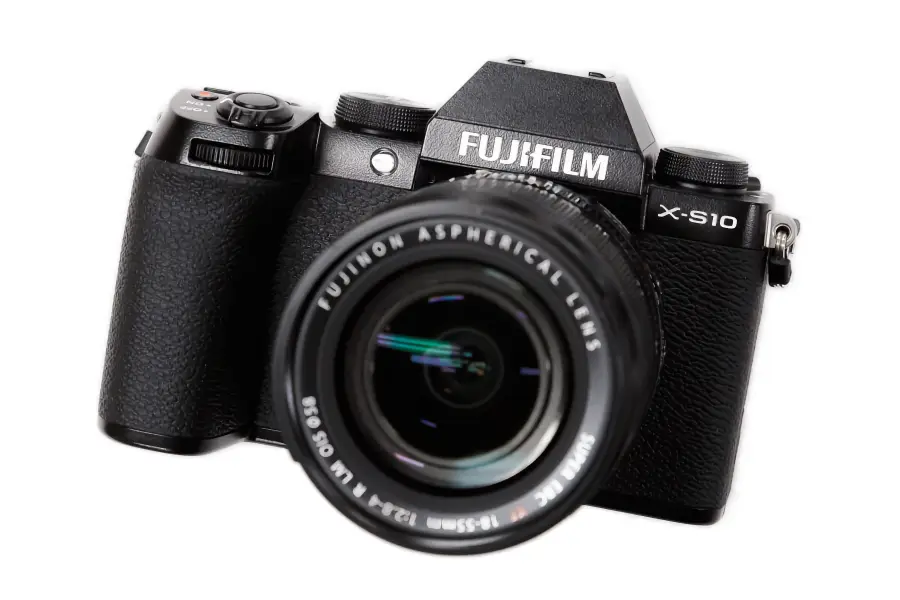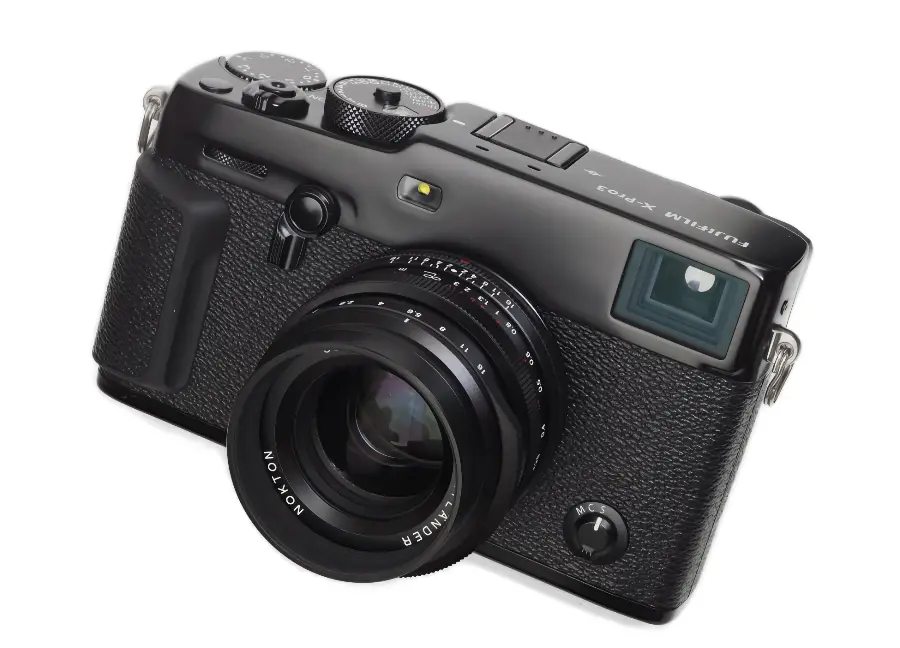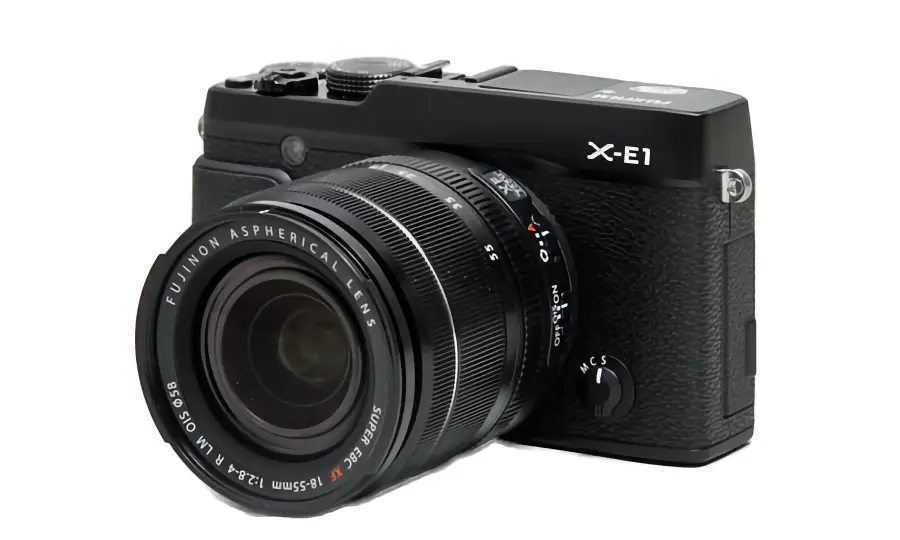
In November 2012, Fujifilm introduced the X-E1, a camera that continues to captivate photography enthusiasts even in 2023. This comprehensive review will explore the X-E1’s key features, pros and cons, and its current value after a decade. We’ll examine whether this classic design and unique image quality still appeal to photographers in today’s digital age.
Key Specifications
| Specification | Details |
|---|---|
| Sensor | 16.3MP X-Trans CMOS (APS-C) |
| Processor | EXR Processor Pro |
| ISO Range | 200-6400 (expandable to 100-25600) |
| Continuous Shooting | Up to 6fps |
| Autofocus | Contrast-detect AF |
| Screen | 2.8-inch 460K dot LCD |
| Viewfinder | 2.36 million dot OLED EVF |
| Video | 1080/24p |
| Weight | Approx. 350g (including battery and memory card) |
| Dimensions | 129 x 74.9 x 38.3 mm |
| Battery Life | Approx. 350 shots (CIPA standard) |
| Storage Media | SD/SDHC/SDXC cards |
🎨 Design & Build Quality
Classic Retro Design

One of the Fujifilm X-E1’s most appealing aspects is its classic retro design. Inspired by traditional rangefinder cameras, this design is not just aesthetically pleasing but also offers practical advantages in use.
Compact and Lightweight Body

The X-E1 boasts excellent portability with dimensions of 129 x 74.9 x 38.3 mm and a weight of about 350g. This makes it ideal for street photography or travel. The difference is particularly noticeable when compared to DSLR cameras of the same era.
Durable Magnesium Alloy Body

The body, crafted from magnesium alloy rather than plastic, provides a lightweight yet sturdy feel. This contributes to its durability over long-term use.
📸 Image Quality & Performance
16.3MP X-Trans CMOS Sensor

The X-E1 features Fujifilm’s proprietary X-Trans CMOS sensor. This sensor uses a unique color filter array different from the traditional Bayer pattern, reducing moiré effects and delivering sharper images.
Fujifilm’s Color Science

One of the greatest strengths of Fujifilm cameras is their excellent color reproduction. The X-E1 continues this tradition, producing beautiful colors in JPEG output. The film simulation modes, in particular, digitally recreate the characteristics of Fujifilm’s famous film stocks.
Low Light Performance

Supporting up to ISO 25600 (expanded), the X-E1 provides usable image quality up to ISO 3200 in typical use. Despite being a decade old, it still offers respectable low light performance by current standards.
🔍 Viewfinder & LCD
High-Resolution OLED Electronic Viewfinder

The 2.36 million dot OLED EVF provided very clear image quality by the standards of its time. While it may lag behind the latest cameras in terms of resolution and response speed, it’s still practical for everyday use.
2.8-inch LCD Screen

The 2.8-inch LCD with 460K dot resolution is small and low-resolution by current standards. However, it’s sufficient for basic image checking and menu navigation. The lack of tilt or touch functionality is a drawback.
🎛️ Handling & User Experience
Intuitive Dial Operation

The shutter speed and exposure compensation dials on top of the camera replicate the operation style of traditional cameras. This allows for quick and intuitive setting changes.
Customizable Buttons

Various function buttons on the camera body can be customized to the user’s preferences, providing a personalized shooting experience.
Menu System

Fujifilm’s menu system is intuitive and well-organized, making it easy even for beginners to use. The Quick Menu function allows fast access to frequently used settings.
🔧 Autofocus & Burst Performance

Contrast-Detect AF System
The X-E1 uses a contrast-detect autofocus system. It’s noticeably slower compared to modern phase-detection or hybrid AF systems. However, it still provides accurate focus for static subjects or landscape photography.
Continuous Shooting Performance
Supporting up to 6fps continuous shooting, it’s slow compared to high-performance modern cameras but sufficient for everyday shooting.
📽️ Video Capabilities
Full HD Video Recording
The X-E1 supports full HD video recording at 1080/24p. The lack of 4K support and limited frame rate options are significant drawbacks by current standards. However, it’s still usable for basic video recording.
External Microphone Support
A 3.5mm microphone input allows for better audio quality in video recording. This can be useful for vlogging or simple interview setups.
🔋 Battery Life & Connectivity

Battery Life
The battery life of about 350 shots (CIPA standard) is respectable even compared to current mirrorless cameras. It’s sufficient for a full day of casual shooting.
Connectivity
The X-E1 offers USB 2.0 and mini HDMI ports. The lack of Wi-Fi functionality means immediate image transfer to smartphones is not possible, which can be inconvenient in today’s social media-centric photography culture.
📊 Comparison with Competitors
vs Sony NEX-7
The Sony NEX-7 is a competitor model released around the same time as the X-E1. While the NEX-7 offers a 24MP sensor and faster continuous shooting, the X-E1 boasts better color reproduction and more intuitive controls.
vs Olympus OM-D E-M5
The Olympus OM-D E-M5, a Micro Four Thirds system camera, is smaller and lighter than the X-E1. While the E-M5 offers more advanced image stabilization, the X-E1 provides better image quality due to its larger sensor size.
vs Fujifilm X-E4
Compared to the latest X-E4 model in Fujifilm’s X-E series, the X-E1 lags in resolution, AF speed, and video capabilities. However, the X-E1 offers a more classic operational feel and unique image characteristics, along with a very affordable used price.
🔍 Lens Compatibility & Selection
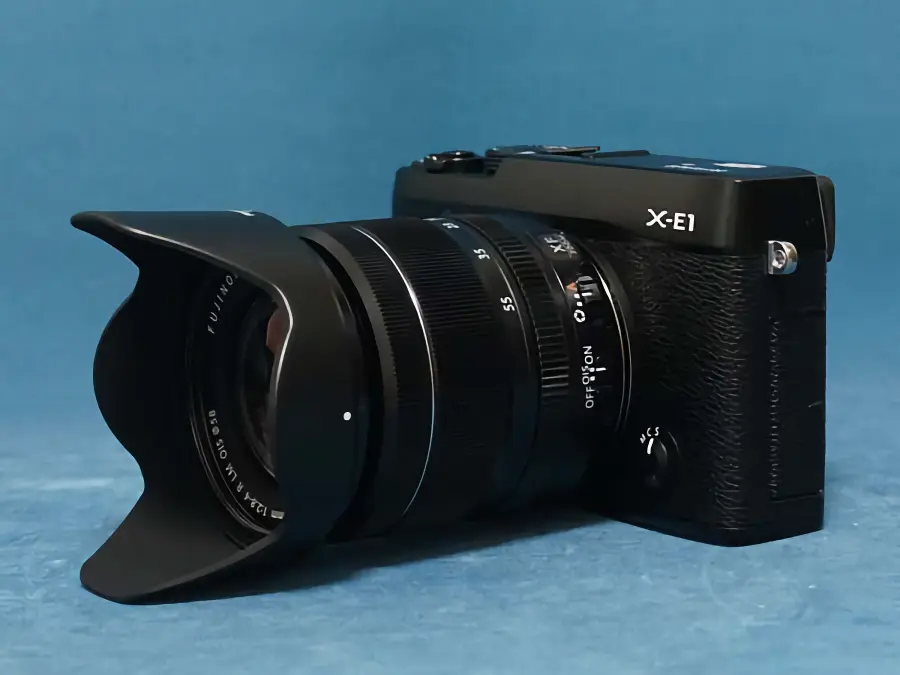
Advantages of the Fujifilm X Mount
The X-E1 uses Fujifilm’s X mount, allowing access to a wide range of high-quality lenses. There’s a broad selection from premium XF series lenses to more economical XC series options.
Recommended Lenses

- XF 35mm f/1.4 R: This standard prime lens pairs perfectly with the X-E1. Its excellent rendering and fast aperture make it versatile for various situations.
- XF 18-55mm f/2.8-4 R LM OIS: A standard zoom lens that’s versatile and offers good image quality.
- XF 27mm f/2.8: A pancake lens that’s extremely small and light, enhancing portability.
💡 Usage Tips & Tricks

Utilizing Film Simulations
Make the most of Fujifilm’s film simulation modes. Provia offers balanced colors suitable for general situations, Velvia is ideal for vibrant landscape photos, and Astia works well for soft portrait images.
Shooting RAW+JPEG
The X-E1 can capture both RAW and JPEG simultaneously. This feature allows you to quickly review images in JPEG format on-site while retaining the flexibility to edit RAW files later.
Leveraging Manual Focus

Given the X-E1’s slower AF performance compared to modern cameras, utilizing manual focus can be beneficial. This is particularly useful for landscape or still life photography where you can achieve more precise focus.
📱 Applying Modern Workflow
Utilizing Eye-Fi Cards
While the X-E1 lacks built-in Wi-Fi, using an Eye-Fi card allows wireless image transfer. This enables a somewhat modern workflow for social media sharing.
Leveraging Mobile Editing Apps
By utilizing powerful editing apps on smartphones, you can edit and share photos taken with the X-E1 on-site. This can somewhat compensate for the camera’s limited connectivity.
💰 Price & Value
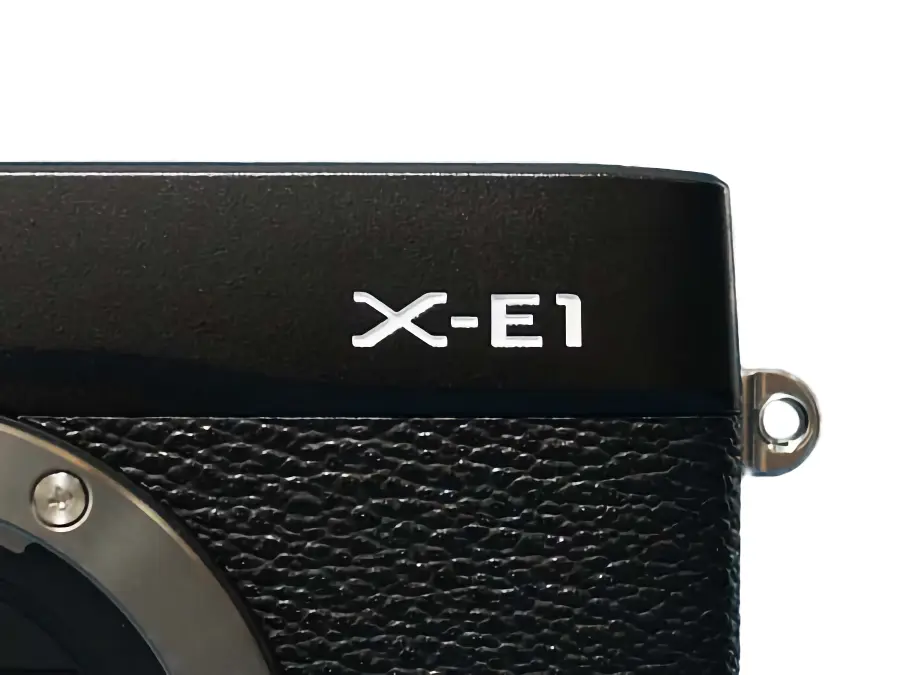
Position in the Used Market
As of 2023, the X-E1 can be purchased at very competitive prices in the used market. The body alone typically ranges from $100 to $150, offering excellent value for money.
Choice for Beginners and Students
The affordable price, excellent image quality, and intuitive operation make the X-E1 an ideal choice for beginners or students entering photography. It’s particularly advantageous for learning the basics of digital photography while also mastering traditional camera controls.
🔧 Maintenance & Durability
Durability
The magnesium alloy body contributes to its robustness. The fact that many X-E1 cameras are still in active use after a decade is a testament to their durability. However, as with any electronic device, component aging over long-term use is inevitable, so checking the condition is important when purchasing.
Repair and Parts Availability
While Fujifilm consistently provides support for older models, parts availability may be challenging for models over 10 years old. It’s advisable to check with your local Fujifilm service center about repair possibilities before purchase.
📸 Real-World Experience & User Reviews

Many users express satisfaction with the X-E1’s image quality and classic operational feel. Fujifilm’s unique color rendition and film simulation modes receive particularly high praise. However, some users point out the slow AF speed and limited video capabilities as drawbacks.
One user commented, “The X-E1 changed my photography philosophy. The slower AF made me more deliberate in my shooting, resulting in better photos.”
🏞️ Landscape Photography Tips
When shooting landscapes with the X-E1, consider these tips:
- Use a tripod: This ensures sharper images in low-light conditions.
- Utilize filters: ND or polarizing filters can enhance your creative options.
- Try the Velvia film simulation: This provides vivid colors ideal for landscape shots.
👤 Portrait Photography Tips
Tips for utilizing the X-E1 for portrait photography:
- Use the XF 56mm f/1.2 R lens: This lens provides beautiful bokeh and sharp portraits.
- Try the Astia film simulation: It offers soft tones that flatter skin.
- Leverage manual focus: This can help achieve precise eye focus.
🌃 Night Photography Tips
X-E1 settings for night photography:
- Tripod is essential: This prevents camera shake for sharp images.
- Use low ISO: Minimize noise by using the lowest possible ISO.
- Long exposure times: This can capture light trails or brighten dark scenes.
🔄 Upgrade Path
If you’re considering upgrading from the X-E1 to a higher-spec camera, you might want to consider the following models:
- Fujifilm X-T20: Offers faster AF and 4K video capabilities.
- Fujifilm X-E3: An advanced model in the X-E series, featuring a touchscreen and improved AF performance.
- Fujifilm X-T30 II: Equipped with the latest sensor and processor, providing significantly improved overall performance.
📊 Summary of Pros and Cons

Pros
- Classic and beautiful design
- Excellent image quality and color reproduction
- Intuitive operation
- Lightweight and compact size
- Very affordable used price
- Compatibility with Fujifilm X mount lenses
Cons
- Slow AF speed
- Limited video capabilities (max 1080/24p)
- Low-resolution LCD screen
- Lack of Wi-Fi functionality
- Lower continuous shooting speed compared to modern cameras
🏁 Conclusion
The Fujifilm X-E1 remains an attractive choice even in 2023. It’s particularly ideal for photography enthusiasts who desire a classic shooting experience or beginners who prioritize value for money. While it may not boast all the latest technology, its excellent image quality, intuitive operation, and above all, the fundamental joy of photography it provides, are the X-E1’s major strengths.
Of course, there are drawbacks such as slow AF or limited video capabilities, but these may not be significant issues depending on the primary use and individual shooting style. Rather, these ’limitations’ might encourage photographers to approach their craft more thoughtfully and creatively.
In conclusion, the Fujifilm X-E1 is highly recommended for photographers who want to experience an analog-like feel in the digital age. Considering its affordable price in the used market, it’s also worth considering as a second camera. However, if you require the latest technology or fast AF, you might want to consider more recent models.
The X-E1 serves as a reminder that great photography isn’t always about having the latest gear. It’s about the photographer’s vision, creativity, and the ability to capture moments. For those who appreciate the process of photography as much as the final image, the X-E1 offers a unique and rewarding experience.
📚 Further Reading and Resources
For those interested in diving deeper into the world of Fujifilm cameras or looking to make the most of their X-E1, here are some valuable resources:
- Fujifilm’s official website: Offers firmware updates, manuals, and support information.
- Digital Photography Review (DPReview): Provides in-depth reviews and comparisons of cameras, including the X-E1.
- Fuji X Weekly: A blog dedicated to Fujifilm cameras, offering tips, tricks, and custom film simulation recipes.
- Fuji Love: An online magazine and community for Fujifilm enthusiasts.
🔧 Maintenance Tips
To keep your X-E1 in top condition:
- Regular cleaning: Use a blower and soft brush to keep the sensor and lens mount clean.
- Firmware updates: Check Fujifilm’s website periodically for firmware updates that may improve performance.
- Battery care: Store batteries at around 40% charge if not using the camera for extended periods.
📸 Final Thoughts
The Fujifilm X-E1 is more than just a camera; it’s a tool that can reignite your passion for photography. Its limitations can become strengths, forcing you to slow down and think more carefully about each shot. In a world of increasingly automated and complex cameras, the X-E1 offers a refreshing return to the fundamentals of photography.
Whether you’re a seasoned photographer looking for a fun second body, a beginner seeking an affordable entry into the world of interchangeable lens cameras, or simply someone who appreciates the aesthetics and tactile experience of a well-designed camera, the X-E1 has something to offer.
Remember, the best camera is the one you have with you, and the X-E1’s compact size and lightweight body make it an excellent companion for everyday photography. Its timeless design and satisfying user experience might just make you want to carry it everywhere.
In the end, while technology marches forward, the X-E1 proves that sometimes, looking back can help us rediscover the joy of photography. It’s a camera that doesn’t just capture images, but also captures the heart of what makes photography so rewarding.






